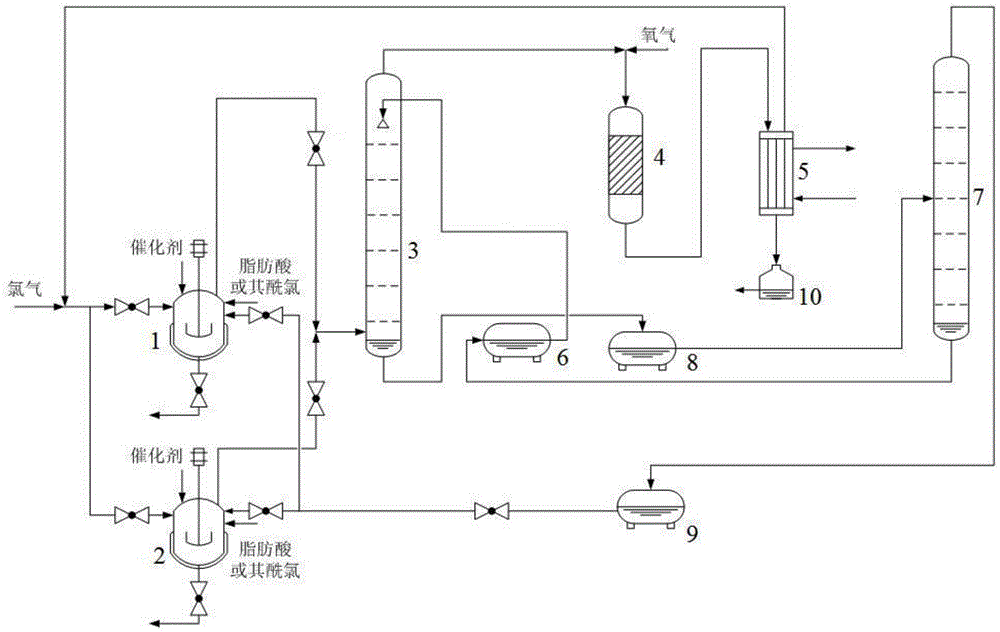Method and system for recycling by-product hydrogen chloride in fatty acid or fatty acyl chloride chlorination production process
A fatty acid chloride and production process technology, which is applied in the field of recycling hydrogen chloride, a by-product in the chlorination production process of fatty acid or fatty acid chloride, can solve the problems of high equipment investment cost and complicated operation.
- Summary
- Abstract
- Description
- Claims
- Application Information
AI Technical Summary
Problems solved by technology
Method used
Image
Examples
Embodiment 1
[0037] at 5m 3 Add 3000kg of fresh acetic acid in the first chlorination reaction kettle, add 100kg mass fraction simultaneously and be the concentrated sulfuric acid of 98.3% as catalyst, at 30 ℃, open the first valve, close the second valve, in the first chlorination reaction kettle Feed into 160kg / h fresh chlorine, carry out chlorination reaction, when the transformation rate of acetic acid in the first chlorination reactor reaches about 97%, the massfraction of chloroacetic acid in the reaction liquid is about 94.1wt% this moment, the dichloroacetic acid The mass fraction is about 3.5wt%, and the unreacted acetic acid mass fraction is about 2.4wt%. With the mass flow rate of 222.2kg / h, fresh acetic acid is continuously passed in the first chlorination reaction kettle, and the concentrated sulfuric acid catalyst is added in the chlorination reaction kettle with the mass flow rate of 7.4kg / h, and with the mass flow rate of 229.6kg / h The flow rate continuously takes out the ...
Embodiment 2
[0043] 5m between 2 sets 3Add 3000kg of fresh acetyl chloride in the chlorination reactor, and add 150kg of concentrated sulfuric acid at the same time, at 30°C, open the first valve, close the second valve, and feed 162.3kg / h of fresh chlorine into the first chlorination reactor. The chlorination reaction is carried out. The chlorination reaction kettle is connected with a -30°C graphite refrigeration heat exchanger, and at the same time, a by-product hydrogen chloride waste gas containing a large amount of organic impurities is produced. The hydrogen chloride waste gas is absorbed and purified, catalytically oxidized, and frozen to remove water. Return to the first chlorination reactor for catalytic chlorination of fatty acid or its acyl chloride. When the conversion rate of acetyl chloride in the first chlorination reactor reaches about 98.5%, the mass fraction of unreacted acetyl chloride in the reaction solution is about 1.3% wt%, the mass fraction of chloroacetyl chlorid...
PUM
| Property | Measurement | Unit |
|---|---|---|
| Particle size | aaaaa | aaaaa |
Abstract
Description
Claims
Application Information
 Login to View More
Login to View More - R&D
- Intellectual Property
- Life Sciences
- Materials
- Tech Scout
- Unparalleled Data Quality
- Higher Quality Content
- 60% Fewer Hallucinations
Browse by: Latest US Patents, China's latest patents, Technical Efficacy Thesaurus, Application Domain, Technology Topic, Popular Technical Reports.
© 2025 PatSnap. All rights reserved.Legal|Privacy policy|Modern Slavery Act Transparency Statement|Sitemap|About US| Contact US: help@patsnap.com

